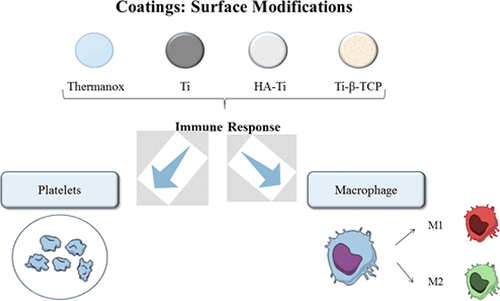当前位置:
X-MOL 学术
›
ACS Biomater. Sci. Eng.
›
论文详情
Our official English website, www.x-mol.net, welcomes your
feedback! (Note: you will need to create a separate account there.)
Biomaterial Property Effects on Platelets and Macrophages: An in Vitro Study
ACS Biomaterials Science & Engineering ( IF 5.4 ) Pub Date : 2017-11-17 00:00:00 , DOI: 10.1021/acsbiomaterials.7b00679 Kelly R. Fernandes 1, 2 , Yang Zhang 1 , Angela M. P. Magri 2 , Ana C. M. Renno 2 , Jeroen J. J. P. van den Beucken 1
ACS Biomaterials Science & Engineering ( IF 5.4 ) Pub Date : 2017-11-17 00:00:00 , DOI: 10.1021/acsbiomaterials.7b00679 Kelly R. Fernandes 1, 2 , Yang Zhang 1 , Angela M. P. Magri 2 , Ana C. M. Renno 2 , Jeroen J. J. P. van den Beucken 1
Affiliation

|
The purpose of this study was to evaluate the effects of surface properties of bone implants coated with hydroxyapatite (HA) and β-tricalcium phosphate (β-TCP) on platelets and macrophages upon implant installation and compare them to grit-blasted Ti and Thermanox used as a control. Surface properties were characterized using scanning electron microscopy, profilometry, crystallography, Fourier transform infrared spectroscopy, and coating stability. For platelets, platelet adherence and morphology were assessed. For macrophages, morphology, proliferation, and polarization were evaluated. Surface characterization showed similar roughness of ∼2.5 μm for grit-blasted Ti discs, both with and without coating. Coating stability assessment showed substantial dissolution of HA and β-TCP coatings. Platelet adherence was significantly higher for grit-blasted Ti, Ti-HA, and Ti-β-TCP coatings compared to that of cell culture control Thermanox. Macrophage cultures revealed a decreased proliferation on both HA and β-TCP coated discs compared to both Thermanox and grit-blasted Ti. In contrast, secretion of pro-inflammatory cytokine TNF-α and anti-inflammatory cytokine TGF-β were marginal for grit-blasted Ti and Thermanox, while a coating-dependent increased secretion of pro- and anti-inflammatory cytokines was observed for HA and β-TCP coatings. The results demonstrated a significantly upregulated pro-inflammatory and anti-inflammatory cytokine secretion and marker gene expression of macrophages on HA and β-TCP coatings. Furthermore, HA induced an earlier M1 macrophage polarization but more M2 phenotype potency than β-TCP. In conclusion, our data showed that material surface affects the behaviors of first cell types attached to implants. Due to the demonstrated crucial roles of platelets and macrophages in bone healing and implant integration, this information will greatly aid the design of metallic implants for a higher rate of success in patients.
中文翻译:

生物材料特性对血小板和巨噬细胞的影响:一项体外研究
这项研究的目的是评估在植入物安装后,用羟基磷灰石(HA)和β-磷酸三钙(β-TCP)涂层的骨植入物的表面特性对血小板和巨噬细胞的影响,并将其与喷砂处理的Ti和Thermanox进行比较作为控件。使用扫描电子显微镜,轮廓仪,晶体学,傅立叶变换红外光谱和涂层稳定性来表征表面性质。对于血小板,评估血小板粘附和形态。对于巨噬细胞,评估其形态,增殖和极化。对于有和没有涂层的喷砂Ti圆盘,表面特性显示出相似的〜2.5μm粗糙度。涂层稳定性评估表明HA和β-TCP涂层已大量溶解。与细胞培养对照Thermanox相比,喷砂处理的Ti,Ti-HA和Ti-β-TCP涂层的血小板粘附性显着更高。与Thermanox和喷砂处理的Ti相比,巨噬细胞培养物在HA和β-TCP包被的椎间盘上均显示出增殖减少。相反,对于喷砂处理的Ti和Thermanox,促炎细胞因子TNF-α和抗炎细胞因子TGF-β的分泌微不足道,而对于HA和HA,观察到涂层依赖性促炎和抗炎细胞因子的分泌增加。 β-TCP涂层。结果证明HA和β-TCP涂层上的巨噬细胞的促炎和抗炎细胞因子分泌和标志物基因表达显着上调。此外,HA诱导的M1巨噬细胞极化更早,但M2的表型效能比β-TCP更高。综上所述,我们的数据表明,材料表面会影响附着在植入物上的第一种细胞类型的行为。由于血小板和巨噬细胞在骨骼愈合和植入物整合中已显示出至关重要的作用,因此该信息将大大有助于金属植入物的设计,从而提高患者的成功率。
更新日期:2017-11-19
中文翻译:

生物材料特性对血小板和巨噬细胞的影响:一项体外研究
这项研究的目的是评估在植入物安装后,用羟基磷灰石(HA)和β-磷酸三钙(β-TCP)涂层的骨植入物的表面特性对血小板和巨噬细胞的影响,并将其与喷砂处理的Ti和Thermanox进行比较作为控件。使用扫描电子显微镜,轮廓仪,晶体学,傅立叶变换红外光谱和涂层稳定性来表征表面性质。对于血小板,评估血小板粘附和形态。对于巨噬细胞,评估其形态,增殖和极化。对于有和没有涂层的喷砂Ti圆盘,表面特性显示出相似的〜2.5μm粗糙度。涂层稳定性评估表明HA和β-TCP涂层已大量溶解。与细胞培养对照Thermanox相比,喷砂处理的Ti,Ti-HA和Ti-β-TCP涂层的血小板粘附性显着更高。与Thermanox和喷砂处理的Ti相比,巨噬细胞培养物在HA和β-TCP包被的椎间盘上均显示出增殖减少。相反,对于喷砂处理的Ti和Thermanox,促炎细胞因子TNF-α和抗炎细胞因子TGF-β的分泌微不足道,而对于HA和HA,观察到涂层依赖性促炎和抗炎细胞因子的分泌增加。 β-TCP涂层。结果证明HA和β-TCP涂层上的巨噬细胞的促炎和抗炎细胞因子分泌和标志物基因表达显着上调。此外,HA诱导的M1巨噬细胞极化更早,但M2的表型效能比β-TCP更高。综上所述,我们的数据表明,材料表面会影响附着在植入物上的第一种细胞类型的行为。由于血小板和巨噬细胞在骨骼愈合和植入物整合中已显示出至关重要的作用,因此该信息将大大有助于金属植入物的设计,从而提高患者的成功率。











































 京公网安备 11010802027423号
京公网安备 11010802027423号